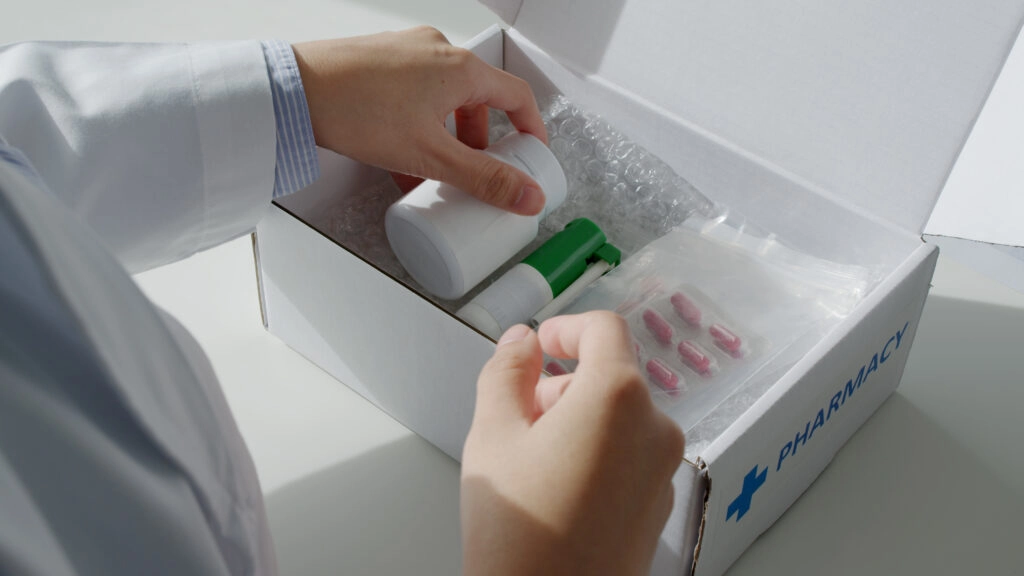5 Sustainable Pharmaceutical Packaging Trends
5 Sustainable Pharmaceutical Packaging Trends
Pharmaceutical packaging is the packaging materials that protect and encase medicine for transport and patient use. These include flasks, vials, syringes, and blister packaging for tablets.
Pharmaceutical packaging differs from food packaging because the substances it holds are more sensitive to its environment. Manufacturers must meet certain standards when producing pharmaceutical packaging. Otherwise, the products could be compromised and risky for patients, as a study on vaccine vials found.
The challenges of producing effective pharmaceutical packaging go beyond safety concerns. Many people have found that the pharmaceutical industry has made at least 87,000 tons of waste in the past few years. Another study found that there has been a rise in plastic waste as COVID-19 immunization efforts unfold worldwide.
These findings underscore the need for pharmaceutical companies to adopt sustainable practices. Experts expect sustainable pharmaceutical packaging to increase demand, helping the industry reduce its environmental impact. Recent sustainable packaging statistics estimate that the market will climb to at least $470 billion by 2027.
The pharmaceutical industry has already taken steps to reduce its waste, and more pharmaceutical brands are discovering new eco-friendly packaging solutions.
Overview of the Pharmaceutical Packaging Market
Pharmaceutical products have strict packaging standards to ensure the safety of patients. In the pharmaceutical packaging market, companies are exploring ways to preserve the quality of their products while still being environmentally friendly.
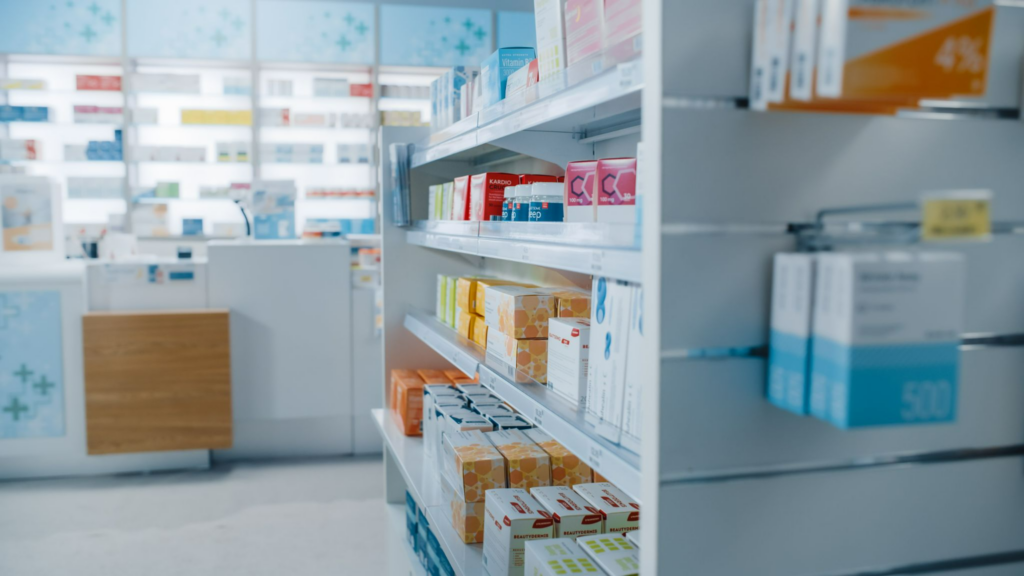
The pharmaceutical packaging industry has come a long way to becoming more sustainable. Read below to see the state of sustainable pharmaceutical packaging so far.
1. The eco-friendly pharmaceutical packaging market is estimated to reach USD 146.3 billion by 2027
Since more governments are imposing stricter regulations and laws, the sustainable pharmaceutical packaging industry is expected to grow by 15.4% in 2027, reaching $146.3 billion.
In 2019, 170 countries in the United Nations pledged to ban plastics by 2030. Another potential reason for the increase in sustainable materials is consumers shifting their demands to more environmentally friendly products. It is true not just in the pharmaceutical industry but across all markets.
2. More than 50 businesses provide sustainable packaging solutions to the healthcare industry
As consumer demand for environmentally friendly products increases, pharmaceutical companies offer eco-friendly pharmaceutical packaging solutions to healthcare industry members. Large pharmaceutical companies are becoming more open to collaboration to reduce their environmental damage.
Schneider Electric, a French company specializing in energy management and automation systems, launched the Energize program in 2021. This collaboration between 10 global pharmaceutical brands was intended to reduce the carbon emissions of their supply chains.
AstraZeneca, a program participant, has already reduced the waste it produces by 18.6%, according to its 2022 Sustainability Report.
3. Sustainable packaging solutions make up a fourth (25%) of the primary pharmaceutical packaging market
According to a new report, large pharmaceutical companies are seeking sustainable packaging innovations to reduce their environmental impact further. Startups are also influential in pushing sustainable pharmaceutical packaging.
For instance, Cabinet Health is a brand focused on providing for the pharmaceutical needs of its consumers while maintaining sustainability demands.
4. Pharmaceutical companies are more ambitious than others in reducing carbon emissions
According to Pharmaceutical Technology, pharmaceutical brands are setting aggressive sustainability goals more than other businesses. The companies aim to reduce their scope 1 and 2 emissions by 45.8% in the next 12 years. These can potentially affect their pharmaceutical packaging supply chain process.
5. Nearly half (46%) of companies in the sector have joined the United Nations Race to Zero campaign
The United Nations Race to Zero campaign continues to rally business leaders to shrink carbon emissions to zero. According to My Green Lab, more businesses in the pharmaceutical industry joined in 2022; campaign participation only reached 31% in 2021.
The popularity of sustainability in the pharmaceutical market has significantly affected its packaging landscape, giving rise to several innovative pharmaceutical packaging trends.
5 Sustainable Pharmaceutical Packaging Trends
Sustainability is manifesting in several creative ways in the pharmaceutical packaging market. Pharmaceutical companies that do not have sustainability as a priority are becoming extinct. Industry leaders must stay updated on the latest findings and practices to allow them to remain relevant. Below are a few pharmaceutical packaging trends disrupting the market.
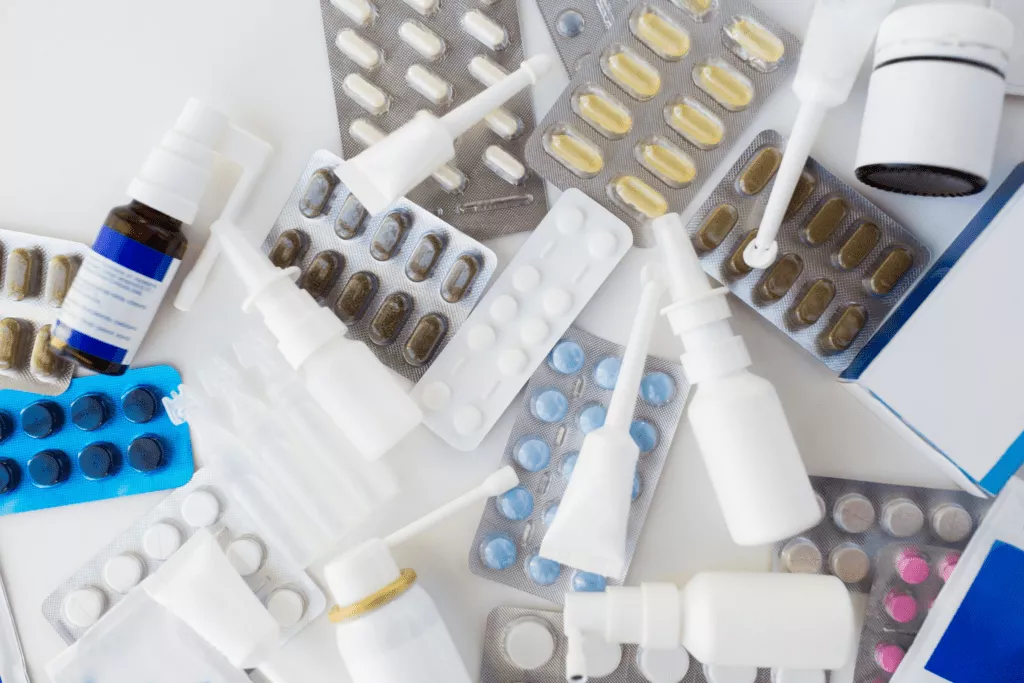
1. Increased use of biodegradable and compostable materials
Biodegradable packaging is a material that microorganisms such as fungi, algae, and bacteria can break down roughly within a year. Some common biodegradable materials include cornstarch and mushrooms. Researchers are experimenting with implementing these materials into their packaging production process.
Some researchers have found that seaweed could be a potential alternative to sustainable bio-packaging in the pharmaceutical, food, and cosmetic industries.
Astellas, a Japanese pharmaceutical company, recently used biomass-based plastic from plant-derived materials for their blister packages. According to their press release, they derived biomass-based plastic, polyethylene, from sugarcane, which accounts for half of the raw material in the package.
2. Adoption of QR codes for packaging
Quick Response (QR) codes on packaging can provide additional functionality to sustainable pharmaceutical packaging. These reduce the need for physical pamphlets or leaflets that would have typically accompanied the pharmaceutical product. This practice is also known as e-labeling.
The EU Regulation (EU) 2021/2226 requires manufacturers and pharmaceutical companies to place QR codes on their packaging. QR codes are becoming familiar on the packaging of pharmaceuticals and medical devices. Industry members can expect to see more of this technology in the coming years.
3. The combination of key product features with the pharmaceutical packaging design
Pharmaceutical product packaging design has allowed brands to innovate and reduce waste. For context, pharmaceutical packaging has three layers: primary, secondary, and tertiary.

The primary packaging layer directly touches the medicine—typically blister packaging or vials. Manufacturers put these inside secondary packaging materials, the boxes customers see at the pharmacy. When manufacturers ship the pharmaceuticals to different institutions, they put the products inside the tertiary packaging.
A trend in the pharmaceutical industry is to print product information and instructions on primary and secondary packaging materials, reducing the need for additional leaflets.
4. Implementation of 3D printing technology into the manufacturing and packaging process
In a study published in the International Journal of Pharmaceutics, researchers suggest that 3D printing technology can benefit pharmaceutical companies and patients. The researchers showed a new way to print personalized medicine packaging. This technology could allow pharmaceutical companies to produce containers with tailored dosages.
This type of pharmaceutical packaging would reduce the amount of redundant equipment manufacturers should produce and use. It will help to reduce waste, saving time and money. Other pharmaceutical brands have found that such technology allows them to test more effectively.
5. Rise of pre-filled pharmaceuticals
Studies have suggested that pre-filled pharmaceutical products are a viable waste-minimizing measure manufacturers can take. These can reduce the manufacturers’ environmental impact and the risk of patients having dosage errors.
An example is PenCycle, pre-filled pens that diabetic patients and patients taking hormonal supplements can use and recycle.
Sustainable Packaging Solutions for Pharmaceuticals
Pharmaceutical companies have plenty of viable eco-friendly options to select from if they want to change their product packaging. Companies like yours can choose from these new materials and product design innovations.
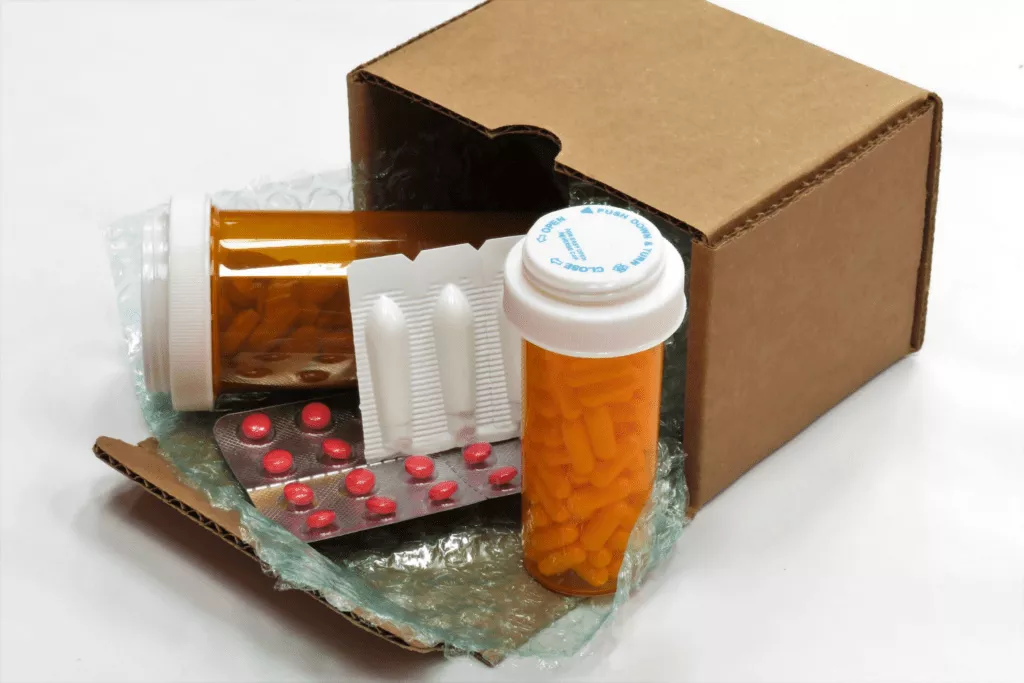
Types of sustainable packaging materials
Manufacturers can make eco-friendly medicine packaging out of many different materials. Below are a few they can consider if they want to pivot to sustainable packaging.
1. Recyclable plastic
There are many types of recyclable plastics, but brands can consider utilizing polyvinyl chloride or vinyl (PVC/V), PCR packaging, or high-density polyethylene (HDPE) to reduce their environmental effect. A study has found that PVC is still the most preferred material for pharmaceutical packaging because of its flexibility.
2. Biodegradable plastic
Biodegradable packaging materials such as cornstarch, mushrooms, and cellulose can break down easily in the environment, making them a great choice for pharmaceutical brands. Not only are biodegradable plastic materials significantly less expensive than typical plastic or metal packaging, but they are also non-toxic and allergen-free.
3. Compostable packaging
Many plant-based packaging solutions are compostable. These include bioplastics, which are created using organic materials such as plants. When these plastics break down, they leave elements that benefit the surrounding environment.
4. Paper-based packaging
Paper-based materials are another avenue brands can explore to reduce waste production. Although some argue that plastic packaging is more sustainable than paper, many consumers still prefer paper. According to a survey, roughly 3 in 5 respondents (63%) chose paper-based packaging over other materials because of its environmental benefits.
Innovations in sustainable packaging design
Pharmaceutical companies are continuing to build creative solutions to reduce their environmental impact. Here are a few innovative, emerging, sustainable pharmaceutical packaging options.
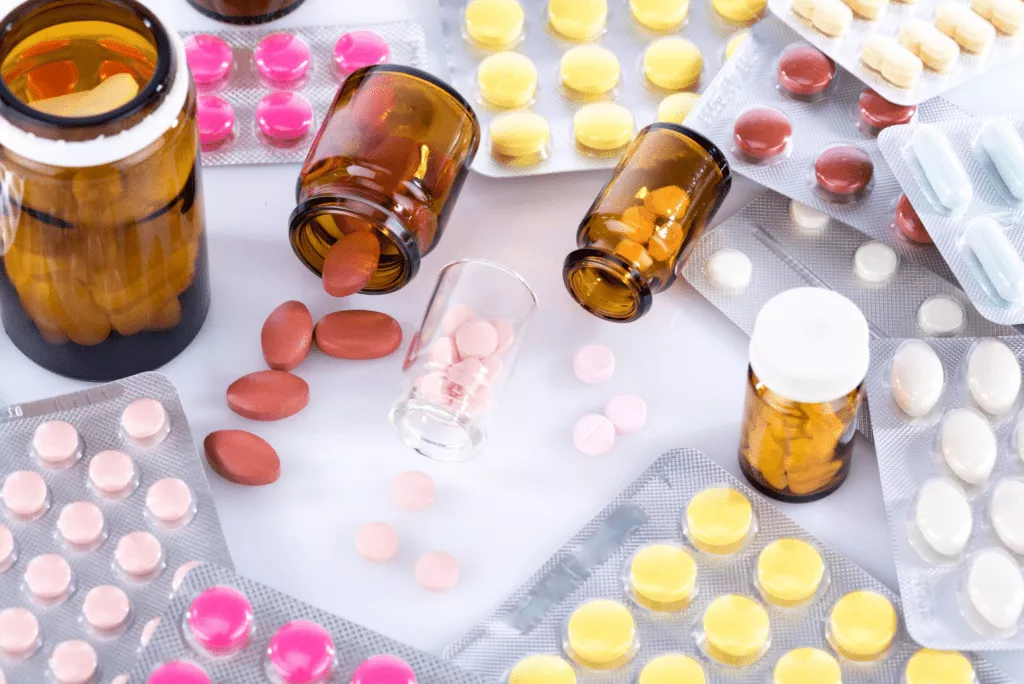
1. Reduction in packaging material
A way that pharmaceutical companies can reduce waste is by limiting the materials they consume and use. Stripping pharmaceutical packages down to the essentials preserves the quality of the medication and can be a potential solution for pharmaceutical companies.
2. Use of renewable energy in manufacturing
Using fossil fuels harms the environment, and large pharmaceutical brands are switching to sustainable energy sources such as solar and wind.
For instance, in their 2022 Sustainability Report, Pfizer reported that they had sourced 7.8% of renewable energy, aiming for steady growth to 80% by 2025 and 100% by 2030.
3. Smart packaging
According to a paper, smart packaging enhances patient compliance, confirms authenticities, supports tracking, and protects against counterfeits. There are two types of smart packaging:
- Active: It can detect the quality of your product and the shipping environment. Manufacturers typically include color-changing inks, microwave susceptors, and oxygen scavengers when building these active smart packaging.
- Intelligent: It includes additional technology, such as Near-Field Communication (NFC). NFC-tagged pharmaceutical packagings allow patients to tap their phones on the package to access additional information, such as video instructions or dosage guides. There is also sensor-embedded pharmaceutical packaging that can improve the user experience of the medication and include it in the Internet of Pharmaceutical Things.
Packaging Medicine for the Environment’s Health
The pharmaceutical packaging industry cannot undo the environmental damage the processes of their previous years caused.
However, the pharmaceutical industry has an opportunity to implement innovative ways to slow the degradation of the environment. Brands across the industry are combining their efforts to develop eco-friendly pharmaceutical packaging solutions.
If your business is looking for innovative, sustainable, and custom folding carton or pressure sensitive label solutions, talk to the printing professionals at Meyers. Contact us today to make your packaging ideas a reality.

